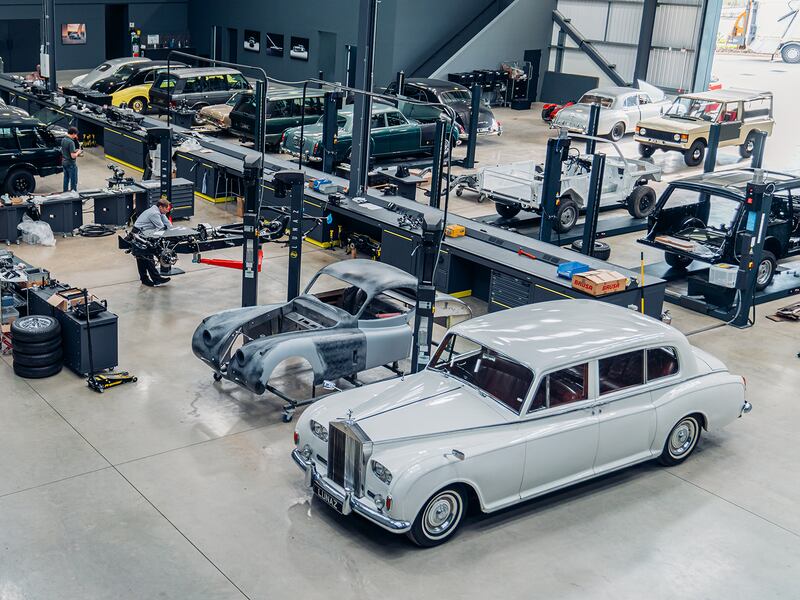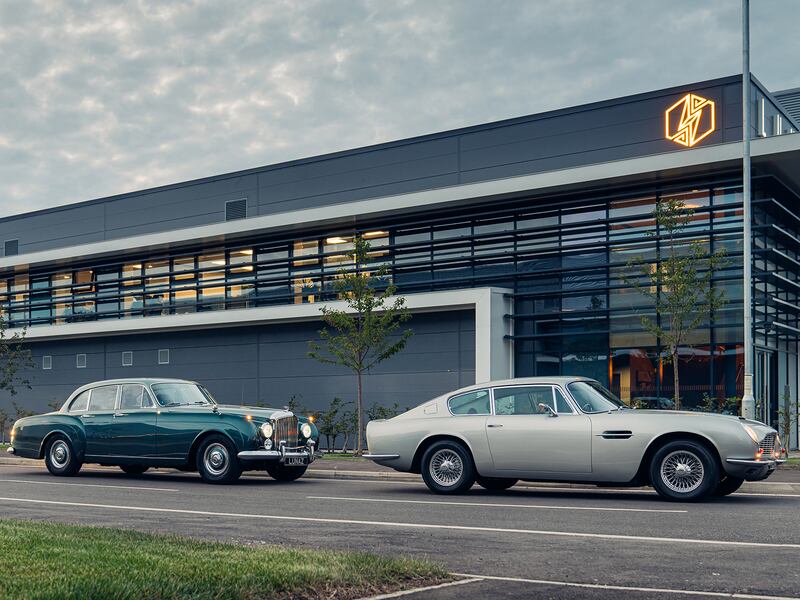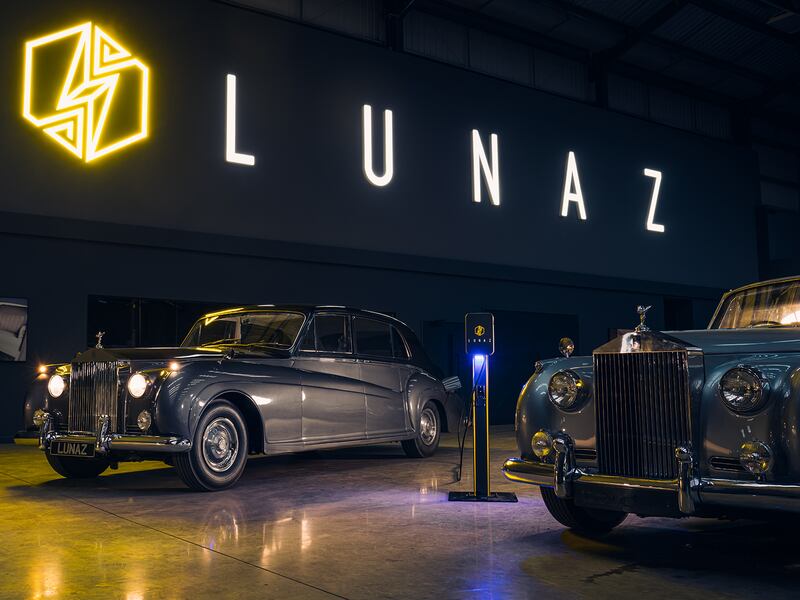
Power Trip: Meet the Classic Car with an Electric Twist
May 10, 2022
I am sitting in the back of a long, elegant, 1960s Rolls-Royce Phantom V. When this classic car was new there were few more glamorous, luxurious ways to travel—on land at least. In comparison with a modern Rolls-Royce, there are few gadgets to play with back here: just silken, pale grey leather upholstery, deep lambswool rugs, and a fine walnut drinks cabinet containing bespoke ceramic tequila decanters in the console between my chauffeur and I.
This is an older, simpler, but deeply compelling notion of automotive luxury, where space, light, and grace are more important than tech.
But the experience is enhanced by one very modern addition: a cutting-edge, emissions-free electric drivetrain. The new seamless, silent powerplant suits this leviathan perfectly. In fact, it enhances it: a Roller was always meant to be near-silent. You simply don't miss the petrol engine. And with a range of around 280 miles (450 km) between charges, you won't miss your appointments either.

This classic car was restored and converted by Lunaz for a private client—who requested those tequila decanters specifically. Based in the UK, within earshot of the Silverstone Formula 1 circuit, Lunaz is among the biggest and best-known exponents of a booming trend: the conversion of high-end classic cars to pure electric power.
Founded by British serial entrepreneur David Lorenz and former Formula 1 race engineer Jon Hilton, whose cars won three F1 World Championships, it has attracted investors from David Beckham to the Barclay family. Demand seems insatiable: Lunaz is currently sold out until 2024, and customers desperate to get their cars sooner are trading build slots.
In addition to the 1950s Jaguar XK sports car that it first offered, and the big Rolls-Royce and Bentley limousines that are popular with high-end hotels, the company now offers early classic Range Rover conversions and its most expensive model to date: an Aston Martin DB6.
Related: Discover What Happens When Car Brand Meets Fashion Styling

"I thought we'd struggle with the DB6 at £1 million ($1.25m)," says James Warren, group commercial director at Lunaz and a former senior Rolls-Royce executive. "But in fact, the earliest build slot I could get you on one of those is well into 2024 now."
If you need something more spacious, the Range Rovers cost from around £300,000 ($376,000), and the Bentleys and Rolls-Royces run between £350,000 ($439,000) and £550,000 ($690,000).
Choose Which Company to Work With
And if you can't wait for a Lunaz, there are plenty of other options. Everrati, based in nearby Oxfordshire, echoes the Lunaz approach by specializing in the conversion of certain models, offering early Land Rovers, Porsche 911s, and an elegant Mercedes-Benz Pagoda.
Others take a different approach. In the United States, LA-based Zero Labs has developed a series of powerful, 600hp electric drivetrains for everything from muscle cars to off-roaders, and which can be fitted to a donor car of your choice. In Austin, Moment Motor Company does the same, and has converted everything from a classic Mini to the rare DeLorean sports car made famous by 1985 movie Back to the Future.

Plenty of other credible contenders enter this fast-growing space every year, and even the mighty Ford Motor Company is getting in on the act, offering the 281hp 'Eluminator' electric motor from its Mustang Mach E for sale separately to those who want to do their own conversions.
"Around 80 percent of our clients are entirely new to classic car ownership," says Warren. "Their other cars might typically be a high-end electric car, such as a Porsche Taycan or a Tesla Model X. They want an electric classic because it's reliable, easy to drive, and sustainable. For a younger generation, driving a combustion-engined car simply isn't something they'd consider."
"But that's not to say that the 'old guard' of collectors is implacably opposed to what we're doing. In fact, our first customer has one of Europe's largest collections of important pre-war cars."
Related: 5 Ways Premium Cars Brands Are Elevating The Luxury Game

Lunaz's modern headquarters is utterly unlike any other classic car restoration business. It's more like a scale model of a luxury carmaker. On the upper floors, teams of engineers led by Hilton work on advanced CAD models of the cars they're modifying. Every car Lunaz offers is digitally scanned, and the electric conversion is planned in the same way as a new model from a major carmaker.
Attention to Detail Is Paramount
Down on the main factory floor you'll find the expected expert metalworkers, who strip every base car back to bare metal, and a trim shop where the fine leather and wood cabins are created. But unlike other restoration businesses, there's also an industrial-looking studio where design director Jen Holloway, formerly of Aston Martin, leads a team of creatives who work with clients to define their perfect combination of colour, trim, and bespoke features. And of course, there's a hermetically sealed engine room, where Lunaz assembles its proprietary electric drivetrains.
The range of classic cars receiving the Lunaz treatment in the main workshop area is extraordinary. Walking around them and hearing their stories is a treat: Warren leads me past one glorious, two-tone gold Rolls-Royce, formerly owned by Sophia Loren, destined for a hotel in Portugal. It's unsurprising that so many customers get closely involved in the build of their cars and visit them as they progress.
Lunaz has increased the range of classic cars it will modify, but it has no plans to seriously increase its output of around one hundred cars each year, keeping its service exclusive despite the demand.

Instead, its growth plans are somewhat unexpected. It has begun 'remanufacturing' refuse collection trucks, using the same tech as in its classic cars to convert them to electric power, improving local air quality. And it treats them to the same bare-metal restoration, saving the embedded carbon from their construction by giving them a completely new lease of life.
The potential market for upcycling commercial vehicles is huge and has the potential to make Lunaz a very big business, even if a refuse truck is a lot less glamorous than a vintage Rolls-Royce.
"They really do have a lot in common though," Lorenz says. "We've redesigned and improved the cabin in the refuse trucks, for example. The guy collecting your bins is sitting in a seat created by a Bentley-trained trimmer."


